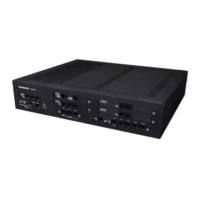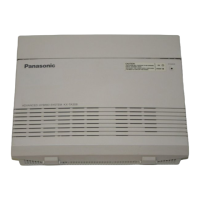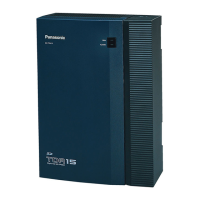→ 4.5 [2-3] Timers & Counters—DISA / Door / Reminder / U. Conf— DISA—Mute & OGM
Start Timer
after answering
• End of Call Detection
If a call through DISA is routed to a trunk, DISA can be used to detect the end of the call. This function can
be disabled through system programming. If disabled, DISA is released when the trunk-to-trunk connection
is made.
The following three types of tone detection can be enabled for each trunk group to disconnect a
trunk-to-trunk call via DISA.
– Silence Detection
→ 5.1 [3-1-1] Trunk Group—TRG Settings—Tone Detection—
DISA Tone Detection—Silence
→ [475] DISA Silence Detection
– Continuous Signal Detection
→ 5.1
[3-1-1] Trunk Group—TRG Settings—Tone Detection—
DISA Tone Detection—Continuous
→ [476] DISA Continuous Signal Detection
– Cyclic Signal Detection
→ 5.1 [3-1-1] Trunk Group—TRG Settings—Tone Detection— DISA Tone Detection—Cyclic
→ [477] DISA Cyclic Signal Detection
• Trunk-to-Trunk Call Duration Limitation
For a call between two outside parties, even if end of call detection cannot be performed, the call can be
disconnected by a system timer. (® 1.11.8 Trunk Call Limitation) If the timer expires, the line will be
disconnected unless the originating caller extends the time by sending any DTMF signalling. The caller
can
prolong the call duration within the preprogrammed time period and preprogrammed number of times.
4.5 [2-3] Timers & Counters—DISA / Door / Reminder / U. Conf
→
DISA—CO-to-CO Call Prolong Counter
→ DISA—CO-to-CO Call Prolong Time
® [210] DISA Trunk-to-Trunk Call Prolong Time
• Automatic DISA Activation
DISA can be set through system programming to automatically activate for the following types of
trunk-to-trunk call, to enable detection of the end of the call.
– When a trunk call is forwarded to another trunk
– When a trunk call is transferred to another trunk
– When
a
trunk call to an incoming call distribution group is answered by an outside destination member
Before the call is made, the PBX confirms that a DISA port is available. If no DISA ports are available, the
call is not routed to a trunk. For transferred calls or calls to an ICD Group, if the DISA port has become
unavailable when the trunk-to-trunk conversation is actually established, the call is established without
DISA.
When using this feature, the Trunk-to-Trunk Call Limitation timer should be enabled. In addition, prolonging
the call through DTMF signalling is not available.
• DISA Call Transfer from Outside Destination
An outside party such as a cellular phone can transfer a trunk call to an extension at the PBX by
pressing "#" + extension number, if DISA is connected by the Automatic DISA Activation feature. This
feature can be enabled or disabled through system programming.
It is also possible to establish a Conference call (® 1.14.1 Conference Features), perform Call Splitting
(® 1.13.3 Call Splitting), and page with a call on hold to transfer the call (® 1.16.1 Paging).
– The KX-NCS4910 or KX-NCS4950 (Activation Key for Software Upgrade to Enhanced Version) is
required to use this feature.
– DISA security mode should be set to No Security or Trunk Security.
– If the called extension does not answer, is busy, or is in DND mode, the DISA Intercept feature operates.
– The party on hold can use the Call Retry feature.
– End of Call Detection does not operate after dialling "#".
– Calls can only be transferred to extensions (not including floating extensions) within the PBX. If the
transferred call is forwarded to another outside destination, COS settings are ignored.
Feature Guide 201
1.17.6 Direct Inward System Access (DISA)

